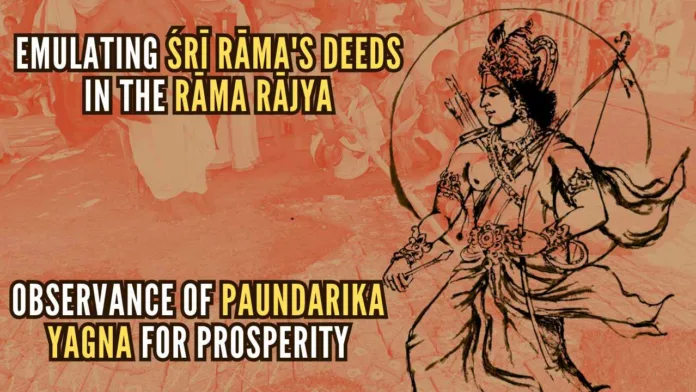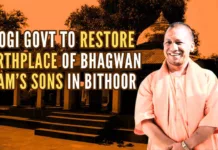
Development, prosperity, and abundance through Vaidika Soma Yāgā-s
“Our aim is not building Ram Mandir alone. Our priority is establishing Rāma Rājya[1]”
“If the country has to turn into a ‘ Rāma Rājya (welfare state), every citizen should turn into Lord Ram. If we adhere to ideals of Rāma, ‘Rāma Rājya’ will materialize automatically,[2]” – HH Śrī Śrī Viśvaprasanna Tīrtha Svāmī-jī, of Pejāvara Adhōkṣaja Math, Udupi &
Member, Shri Ram Janmabhoomi Teerth Kshetra Trust.
We are living in momentous times in the wake of the historic installation of Balak Rāma in the Mandir made for Śrī Rāma Lalla Virājmān at the Śrī Rāma Janmabhūmi in Ayodhya. This is only a beginning for ushering in the reign of Rājā Rāma – the ‘Rāma Rājya‘ – the best polity that ever existed where every person had all their four pursuits of life – the puruṣārtha-s – Dharma, Artha, Kāma and Mokṣa – fulfilled.
Rāma is Dharma-personified. The aspiration for prosperity is found across the board in our country today. What means did Śrī Rāma use in the ‘Rāma Rājya’ for attaining prosperity, development, and abundance that includes the heart to give aplenty (the word for prosperous in our tradition being – subhikṣa) in all His people? One insightful response that we learn from the Vālmīki Rāmāyaṇa (Śloka 6.128.95 )is by looking at the yajña-s observed by Him. Of the many yajña-s – some of which were performed by Him many times over, three of the Soma Yāga-s are specifically named:
- Pauṇḍarīka
- Aśvamedha
- Vājapeya.
While Aśvamedha is known to fulfill all desires including that of prosperity and victory in an all-conquering conquest (Āśvalāyana Śrauta Sūtra 10.6.1) and Vājapeya is observed by one who is desirous of lordship [ādhipatya] (Āśvalāyana Śrauta Sūtra 9.9.1) – there is little public memory of Pauṇḍarīka mentioned first in the list of yajña-s named by Vālmīki. Pauṇḍarīka is observed with the desire for ṛddhi (prosperity, abundance – of all eight forms of wealth (aṣṭaiśvarya)) (Āśvalāyana Śrauta Sūtra 10.4.1).
As a nation desirous of being prosperous and developed in the best sense imaginable and with an abundance that comes with a heart to give aplenty, we are fortunate that there is a living tradition of Āhitāgni-s (those Brāhmaṇa-s who do the upāsana (worship) of the three Vedic fires – gārhapatya – dakṣiṇa – āhavanīya – by keeping them alive perpetually in their family) who carry the know-how of observing the Pauṇḍarīka yāga to this day. In the Andhra, it is said that one of the most remarkable re-invigoration of the observance of Pauṇḍarīka yāga happened in the 1960s when Brahmaśrī Dendukūri Veṅkaṭappa Yajñanārāyaṇa Somayājin (Kṛṣṇa Yajurveda Sāṅga-Salakṣaṇa-Sarahasya Ghanānta Svādhyāyi) who also learnt the mantra-bhāga of Ṛg Veda as well as Sāma Veda (Kauṭhuma Śākha) for the observance (anuṣṭhāna) of Pauṇḍarīka yāga as well as the entire procedure for the same by studying various texts – including the Śrauta Sūtra-s of Ṛg Veda (Āśvalāyana), Kṛṣṇa Yajurveda (Āpastamba) and Sāma Veda (Drāhyāyana) – and having made a due assessment of the relative differences in them – he prepared hand-written copies of the entire Kalpa (manual/ procedure) for the observance of both forms of Pauṇḍarīka yāga – Vyūḍha and Samūḍha. It is recalled even to this day with great wonderment about the wonderful manner in which the Vyūḍha Pauṇḍarīka yāga was observed by him in the year 1966 CE as the Yajamāna on the banks of River Krishna in Krishnalanka, Vijayawada [some may recall that the food shortage in India was overcome in the subsequent years] and despite severe rationing elsewhere, Anna Samārādhana happened without any hindrance as the local authorities also believed in the successful conduct of yajña to result in abundance in future.
Brahmaśrī Dendukūri Veṅkaṭappa Yajñanārāyaṇa Pauṇḍarīka Yājin paved the way for the performance of several Vyūḍha Pauṇḍarīka yāga-s in the Telugu state. In the year 1994 CE, he got his second son Brahmaśrī Dendukūri Veṅkaṭeśvara Dīkṣitulu to observe the Vyūḍha Pauṇḍarīka yāga under his supervision and also desired that the Pauṇḍarīka yāga of the Samūḍha form – which is indicated as the primary form of Pauṇḍarīka yāga in the Āśvalāyana Śrauta Sūtra be observed by Brahmaśrī Dendukūri Veṅkaṭeśvara Dīkṣitulu (Vyūḍha Pauṇḍarīka Yājin). It was however not to be. After a few years, with the passing away of his wife, Brahmaśrī Dendukūri Veṅkaṭappa Yajñanārāyaṇa Pauṇḍarīka Yājin took sannyāsa with the name Svāmi Jñānānanda Tīrtha. He attained siddhi soon after.
This year happens to be the Birth Centenary Year of Svāmi Jñānānanda Tīrtha, and despite being seventy plus – we are fortunate that the able and scholarly Brahmaśrī Dendukūri Veṅkaṭeśvara Dīkṣitulu (Vyūḍha Pauṇḍarīka Yājin) – has resolved to fulfill the desire of his father and Guru – Svāmi Jñānānanda Tīrtha – by observing the Samūḍha Pauṇḍarīka yāga.
How are we fortunate? Soma Yāga-s, by their very nature, are observed only for the sake of the well-being of the entire world. This particular Soma Yāga is particularly meant for our collective prosperity. There is something more to it also. There is an adage in Sanskrit – एक क्रिया द्व्यर्थि करी बभूव – that all the Vaidika Karma-s have a simultaneous benefit – one which is visible (dṛṣṭa) and the other, invisible (adṛṣṭa) and long term. It is also asserted: अत्युत्कटैः पुण्यपापैरिहैव फलमश्नुते – that is, anything done so exceptionally, whether it is for merit (puṇya) or demerit (pāpa) – the fruit of it shall be obtained in this world itself.
The proper performance of the Yāga calls for yajña sāmagri – from all kula vṛtti-s – indicating how it is yajña that unites all the people belonging to various jāti-s with varying kula-vṛtti-s. The visible fruit of the conduct of the yajña is in the material benefit and livelihood (or wealth re-distribution as some economists would like to call it) to all the people, who while working on their own expertise, also beget the invisible fruit of being part of the yajña (apūrva phala). How do we reap the benefit of the invisible fruit? It is said in the Mahābhārata[4] – Soma Yāga-s please the Devatā-s because Soma-juice is the food for them. When they are pleased, and they decide to protect us – they do not do it the way a cowherd/shepherd protects the cows/ sheep by driving them away from danger using a stick. They do it by giving us a proper sense of discernment (viveka/ buddhi) to do our things better and thereby prosper.
Yajña invokes the entire cosmos into the substance that we work with. And everyone part of it has an equal share as is urged:
कर्ता कारयिता चैव प्रेरकश्चानुमोदकः । सुकृतेदुष्कृते चैव चत्वारः समभागिनः ॥
The doer, the enabler, the promoter as well as the endorser – each one has an equal share in the conduct of both good deeds as well as bad.
This is an invitation to all those who believe in the above to join and ensure the proper observance of the Caturthāgni yukta Samūḍha Pauṇḍarīka Yāga – on our path towards realizing Rāma Rājya.
Śrī Rāma Jaya Rāma Jaya Jaya Rāma
Caturthagni Yukta Samudha Paundarika Yagam – English Invitation by PGurus on Scribd
Note:
1. Text in Blue points to additional data on the topic.
2. The views expressed here are those of the author and do not necessarily represent or reflect the views of PGurus.
Reference:
[1] Udupi: Funds collected for Ram Mandir have crossed Rs 1,000 crore, says Pejawar Swamiji – Feb 10, 2021, Daijiworld
[2] Udupi: ‘People should become Rams, create Ram Rajya’ – Pejawar Swamiji – Aug 06, 2020, Daijiworld
[3] Asvalayana-Srautasutra – Gretil
[4] न देवा दण्डमादाय रक्षन्ति – Vedadhara
For all the latest updates, download PGurus App.










